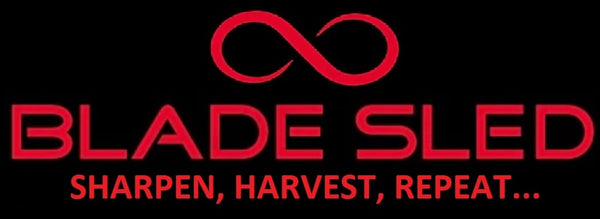Sharpening
Warning: Keep fingers away from blade edge!
Microscope Photos of Used and Sharpened blades
Initial Blade Position:
Insert a blade to sharpen in the jaws of the clamp and snug the machine bolt lightly so the blade is held in place firmly but can be moved with your fingers. Position the blade so it is extended about 3/16" from the face of the clamp for all but Magnus. For Magnus Stinger main blades extend the blade 1/4" from the face of the clamp. Adjust the blade so that the edge to sharpen is parallel to the face of the jig. Tighten firmly but don't crank it down yet.
Final Blade Alignment:
After initial blade positioning, use a black Sharpie style marker to color the surface to be sharpened on both sides. Place 1/2 sheet or full sheet of 220 or 400 grit sandpaper* on a very flat surface. A piece of glass is ideal. Tape the sand paper down with masking or duct tape. Lay the jig with blade on the sandpaper and with light pressure, push and pull the blade sled a few times, then flip it over and repeat. Inspect the wear pattern of the marker. If the marker is not sanded off of the blade edge at 19 degrees, change the axle to the position closer to the blade for 21 degrees. If still to shallow, move axle to 23 degree position. Magnus can be sharpened to 21 degrees but it takes a little more effort to reface the blade edge than the smaller blades tested. For Magnus I recommend 220 grit if you are creating a new face for the edge then use 400, 800, or 1000 grit to sharpen.
Check if the edge is parallel to the sanding action. Inspect the sanding pattern if it is wearing off one end more than the other or if the wear pattern is aligned with the blade edge. If uneven end to end, loosen the screw 1/4 turn and adjust the blade to correct the angle and tighten. Use the marker on both sides of the surface to be sharpened again. Sand both sides again and check the wear pattern and adjust again until you get an even wear pattern. Once you have an even pattern go ahead and tighten it solidly by hand with a screwdriver. Now you are ready to sharpen.
Sharpening New and Used Blades:
(For Magnus, see below) If the blade is slightly bent or damaged, start with 220 grit. If the blade is new or used but not bent, start with 400 grit. Follow the process similar to how a butcher uses a sharpening steel. Sand smooth, long, even strokes on the sandpaper back and forth 10 times. Flip the jig and repeat 10 times. Flip the jig and sand 8 times, Flip the jig and sand 8 times. Repeat this process for 6, 4, 2 then 1 stroke.
For Magnus, once you have the blade edge positioned 1/4" from the face of the clamp and have the Sharpie wearing evenly across the face, start with 220 grit. If it is the first time this blade is sharpened with the Blade Sled, you will need 20 or more strokes on each side to get a clean edge face. Once you have a clean face, use the 220 grit and do a sequence of 10 flip 10, 6 flip 6, 3 flip 3. Switch to a new sheet of 400 grit and do a full sequence starting at 10 and descending to single strokes. 10 flip 10 flip 9 flip 9 flip 8 flip 8...down to 1. To get even sharper, repeat the 10,9,8... sequence using 800 or 1000 grit. When you get down to 1 stroke, use light pressure and just sand the blade on the pull stroke and repeat about 5 times..try again if it doesn't work the first time. Soon you will figure it out. Follow these instructions carefully for best results.
* Silicon Carbide sandpaper is recommended, but any sandpaper for metal will work.
Finding the Best Angle:
Start with the 19 degree degree axle setting. (The axle slot farthest away from the bolt) Mark your blade with a sharpie. Place on medium grit sandpaper like 400 grit. Make a few strokes back and forth with light pressure. Flip jig and make a few more strokes back and forth. Check the wear pattern. If the edge of the blade still has the Sharpie on it, the angle is too shallow. Change the axle position to 21 degrees and repeat test. If the angle is too shallow, change the axle position to the 23 degree slot. (axle slot closest to bolt) Most blades can be sharpened at 19 degrees.
Sharpening Bent Blades:
I used to throw away bent blades. Now I bend them back as straight as I can with two pair of pliers then sharpen them in the Blade Sled. Of course, there are limits to damage that can actually be sharpened. However, I have not thrown away any bent blades since I began using the Blade Sled.
After bending the blade as straight as you can. The process is the same as a non-bent blade. But when sharpening, you will see uneven areas getting sharpened and leaving marker. Once the blade is close enough to straight, you can keep sanding and form a new bevel. If 400 grit is taking too many strokes, try using 220 grit to speed up the process. Then go back to 400 then 800 or 1000 grit to complete sharpening.
